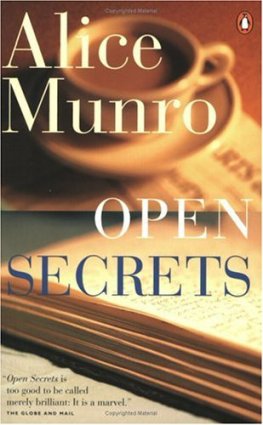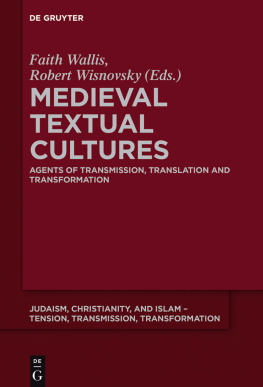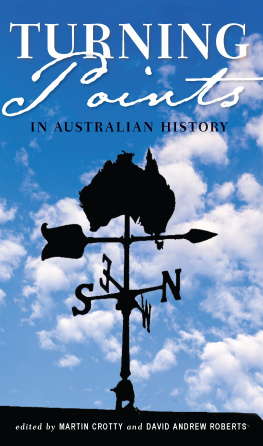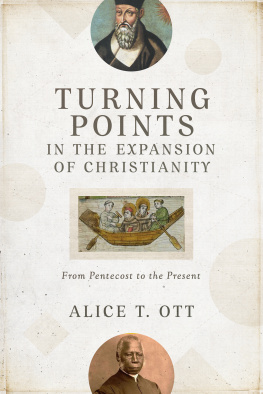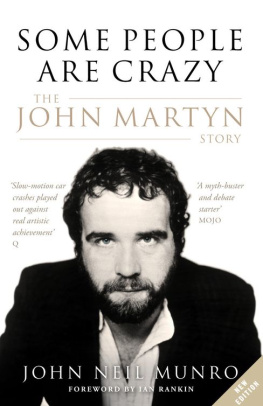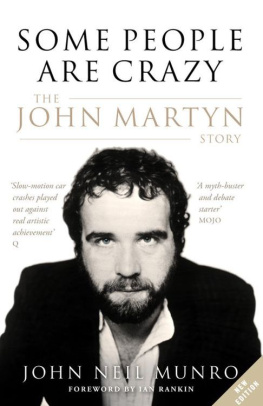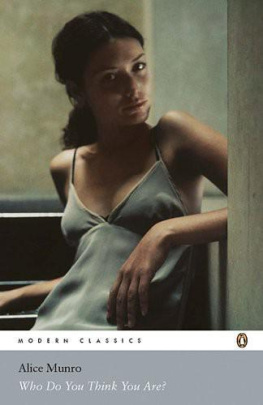John Munro (editor) - Reading the postwar future : textual turning points from 1944
Here you can read online John Munro (editor) - Reading the postwar future : textual turning points from 1944 full text of the book (entire story) in english for free. Download pdf and epub, get meaning, cover and reviews about this ebook. year: 2020, publisher: Bloomsbury UK, genre: Politics. Description of the work, (preface) as well as reviews are available. Best literature library LitArk.com created for fans of good reading and offers a wide selection of genres:
Romance novel
Science fiction
Adventure
Detective
Science
History
Home and family
Prose
Art
Politics
Computer
Non-fiction
Religion
Business
Children
Humor
Choose a favorite category and find really read worthwhile books. Enjoy immersion in the world of imagination, feel the emotions of the characters or learn something new for yourself, make an fascinating discovery.
- Book:Reading the postwar future : textual turning points from 1944
- Author:
- Publisher:Bloomsbury UK
- Genre:
- Year:2020
- Rating:5 / 5
- Favourites:Add to favourites
- Your mark:
- 100
- 1
- 2
- 3
- 4
- 5
Reading the postwar future : textual turning points from 1944: summary, description and annotation
We offer to read an annotation, description, summary or preface (depends on what the author of the book "Reading the postwar future : textual turning points from 1944" wrote himself). If you haven't found the necessary information about the book — write in the comments, we will try to find it.
Reading the postwar future : textual turning points from 1944 — read online for free the complete book (whole text) full work
Below is the text of the book, divided by pages. System saving the place of the last page read, allows you to conveniently read the book "Reading the postwar future : textual turning points from 1944" online for free, without having to search again every time where you left off. Put a bookmark, and you can go to the page where you finished reading at any time.
Font size:
Interval:
Bookmark:

READING THE POSTWAR FUTURE
For Theo and Clara Walker,
and for Clara and Roland Maloney,
who are the future.
READING THE POSTWAR FUTURE
Textual Turning Points from 1944
Edited by
Kirrily Freeman and John Munro

Contents
Kirrily Freeman
Radhika Desai
Michael DArcy
Luke Foster
Sarah Frank
Radhika Natarajan
Ajay Parasram
Chikako Nagayama
Suzanne Langlois
Katherine Rye Jewell
Chike Jeffers
Alan M. Wald
Rebecca E. Karl
John Munro
This volume began as a cross-corridor conversation along the lines of Have you ever noticed how many influential books were written in 1944? That conversation developed, over lunch and coffee, between marking and meetings, into a workshop at Saint Marys University in October 2017, organized with our friend and colleague Xiaoping Sun. A Social Sciences and Humanities Research Council Connection Grant and support from the SMU History Department, Faculty of Arts, Faculty of Graduate Studies and Research, and Presidents Office were indispensable for bringing together a number of scholars whose work features in this collection. We would like to thank them all for their early enthusiasm and continued support for the project. We especially thank Xiaoping who, though she was not able to contribute to the present volume, shaped the larger venture in invaluable ways.
Kirrily Freeman would like to thank colleagues and students in the History Department at Saint Marys University, especially Trisha Turner and Susan Haines who were of great help in organizing the workshop part of this project. Theo, Clara, and Colin Walker are my reason for being, and Im so grateful for their love and encouragement.
John Munro would like to thank the American Studies Program at the University of Tbingen, the Institute for English and American Studies at the University of Rostock, and the Alexander von Humboldt Foundation for their generous support. In particular, I would like to thank Katharina Motyl, Astrid Franke, and Gesa Mackenthun for the warm welcome you gave me at your respective institutions as I worked on this volume. For me, this book began in Canada and ended in England, and I would also like to thank my colleagues in the History Departments at Saint Marys University and the University of Birmingham for their support. My gratitude is immense to Clara and Roland Maloney for, among other things, distracting me from always thinking about the past by keeping me in the joys of the present. And, as ever, I am grateful for Jacqueline Maloneys support, patience, and love.
In the publication of this volume, we would both like to thank Maddie Holder and Dan Hutchins at Bloomsbury. They have shepherded us swiftly and expertly through the whole process, and we couldnt have asked for better guiding hands. We are also grateful for the helpful feedback from the anonymous reviewers who took the time to improve this book with their wise suggestions, and to Joseph Gautham for his assistance at the production stage. To the workshop participants, thank you for what was a wonderful set of papers and conversations. To the contributors who joined this project after the workshop, and who took up our request (often out of the blue) to write something new on a short timeline, we are equally thankful.
Lee Miller, Ruined street , Saint-Malo, France, 1944. Courtesy Lee Miller Archives. |
A promotional photo for Kurosawa Akira, The Most Beautiful (1944). Courtesy Toho |
Waiting for food. In the Wake of the Armies: UNRRA (1944). National Film Board of Canada. |
A displaced family. UNRRA Goes into Action (1945). National Film Board of Canada |
The Hungarian-made motorcycle Iron Man Wang [Jinxi] rode in the Daqing oil fields in the 1960s. Iron Man Wang was a Mao-era model worker. The oil tank is inscribed, in Maos calligraphy, with the political injunction, Serve the People. The motorcycle is on display at the Wang Jinxi Memorial Hall in Daqing. Photo by Maggie Clinton. |
Kirrily Freeman
Lee Miller was the only war correspondent in Saint-Malo in early July 1944. The US army had sent her there by mistakefemale reporters were meant to stay well behind the linesbut, sheltering in the rubble of the city still under bombardment, Miller photographed the devastation of Saint-Malo and its population ( Miller and Gellhorn, like so many of their colleagues, were well aware that what they were reporting on was not only the invasion of fortress Europe, but the opening of the final phase of the war.
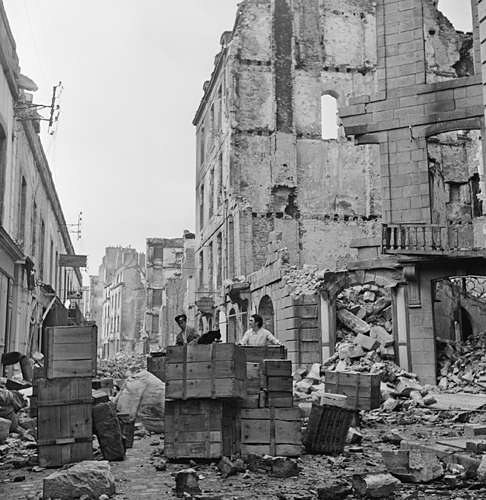
Lee Miller, Ruined street , Saint-Malo, France, 1944. Courtesy Lee Miller Archives.
The year 1944, and D-Day in particular, occupy a central place in the national memories of the British and North American publics.
While 1944 appears as a major turning point in both memory and retrospect, Reading the Postwar Future demonstrates that it also felt that way at the time. From the Allied landings in Papua New Guinea on January 2which launched Operation Cartwheel in the South Pacificto the news from Los Alamos on December 30 that an American atomic bomb would soon be ready for testing, from the formal establishment of Charles de Gaulles French Forces of the Interior on February 1 to Heinrich Himmlers November 24 order that the crematoria at Auschwitz be destroyed in light of the inexorable westward march of the Soviet Red Army, the events of 1944 portended that an end to the conflict, if not imminent, was certainly coming into view. Just how the war would conclude remained subject to speculation, but 1944 brought a growing sense of certainty as to who the ultimate victors would be.
Allied progress in 1944from the west and from the eastsuggested not only that a postwar future could now be contemplated but also that it must, imperatively, be planned. The Big ThreeChurchill, Roosevelt, and Stalinhad been preparing for the liberation of Europe since 1943, but there was a widespread feeling, inspired not least by the lessons of the last war and its aftermath, that the scale of the global crisisand the geopolitical shifts that would accompany itrequired initiatives that were unprecedented in both scope and creativity and that solutions ought not be left solely to the leaders of these three governments alone. At the same time, six or more years of privation, restrictions, fear, and violence had marked people profoundly. This most devastating war in human history had such deeply dislocating effects that it left many yearning for normalcy, but uncertain about how they could emerge from the wreckage.
And what wreckage there was. Our cover photo shows the city of Cologne after round-the-clock Allied bombing raids in the fall of 1944, providing a strikingly different perspective from Lee Millers photographs of the ruins of Saint-Malo. The complete reconstruction of cities and infrastructures and the rehabilitation of communities and institutions, often from the ground up, would be required on a global scale.
Because of the magnitude of destruction already evident in 1944, the progression of Allied victories, and the beginning of relief and rehabilitation efforts for defeated and liberated populationsand perhaps despite the years place in national memorieshistories of the war often fold 1944 into what scholars have termed the long 1945. In the most immediate way, as Year Zero, 1945 marked the formal end of the war and the beginning of a postwar era characterized by the aftermath of liberation, defeat, victory, or conquest; by ongoing social and economic crisis and upheaval; by transitional or provisional politics and government; and by the initiation of programs aimed at a return to order.
Font size:
Interval:
Bookmark:
Similar books «Reading the postwar future : textual turning points from 1944»
Look at similar books to Reading the postwar future : textual turning points from 1944. We have selected literature similar in name and meaning in the hope of providing readers with more options to find new, interesting, not yet read works.
Discussion, reviews of the book Reading the postwar future : textual turning points from 1944 and just readers' own opinions. Leave your comments, write what you think about the work, its meaning or the main characters. Specify what exactly you liked and what you didn't like, and why you think so.


